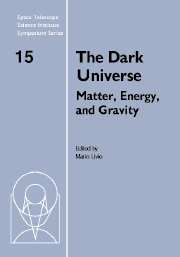Book contents
- Frontmatter
- Contents
- Participants
- Preface
- A brief history of dark matter
- Microlensing towards the Magellanic Clouds: Nature of the lenses and implications on dark matter
- Searching for the Galactic dark matter
- Hot gas in clusters of galaxies and ΩM
- Tracking the baryon density from the Big Bang to the present
- Modified Newtonian Dynamics and its implications
- Cosmological parameters and quintessence from radio galaxies
- The mass density of the Universe
- Growth of structure in the Universe
- Cosmological implications of the most distant supernova (known)
- Dynamical probes of the Halo Mass Function
- Detection of gravitational waves from inflation
- Cosmological constant problems and their solutions
- Dark matter and dark energy: A physicist's perspective
Searching for the Galactic dark matter
Published online by Cambridge University Press: 21 August 2009
- Frontmatter
- Contents
- Participants
- Preface
- A brief history of dark matter
- Microlensing towards the Magellanic Clouds: Nature of the lenses and implications on dark matter
- Searching for the Galactic dark matter
- Hot gas in clusters of galaxies and ΩM
- Tracking the baryon density from the Big Bang to the present
- Modified Newtonian Dynamics and its implications
- Cosmological parameters and quintessence from radio galaxies
- The mass density of the Universe
- Growth of structure in the Universe
- Cosmological implications of the most distant supernova (known)
- Dynamical probes of the Halo Mass Function
- Detection of gravitational waves from inflation
- Cosmological constant problems and their solutions
- Dark matter and dark energy: A physicist's perspective
Summary
A straightforward interpretation of the MACHO microlensing results in the direction of the Magellanic Clouds suggests that an important fraction of the baryonic dark matter component of our Galaxy is in the form of old white dwarfs. If correct, this has serious implications for the early generations of stars that formed in the Universe and also on the manner in which galaxies formed and enriched themselves in heavy elements. I examine this scenario in some detail and in particular explore whether the searches currently being carried out to locate local examples of these MACHOs can shed any light at all on this scenario.
Introduction
A conservative estimate of the mass of the Galaxy out to a distance of about 2/3 of that of the Large Magellanic Cloud is MG = 4 × 1011 M⊙ (Fich & Tremaine 1991). With a total luminosity in the V-band of 1.4 × 1010 L⊙ (Binney & Tremaine 1987) the Galactic mass to light ratio in V (M/Lv) out to 35 kpc is ∼ 30. Since normal stellar populations do not generally produce M/Lv ratios higher than about 3, this is usually taken as evidence for an important component of dark matter within an extended halo surrounding the Galaxy.
- Type
- Chapter
- Information
- The Dark UniverseMatter, Energy and Gravity, pp. 24 - 33Publisher: Cambridge University PressPrint publication year: 2004
- 2
- Cited by



